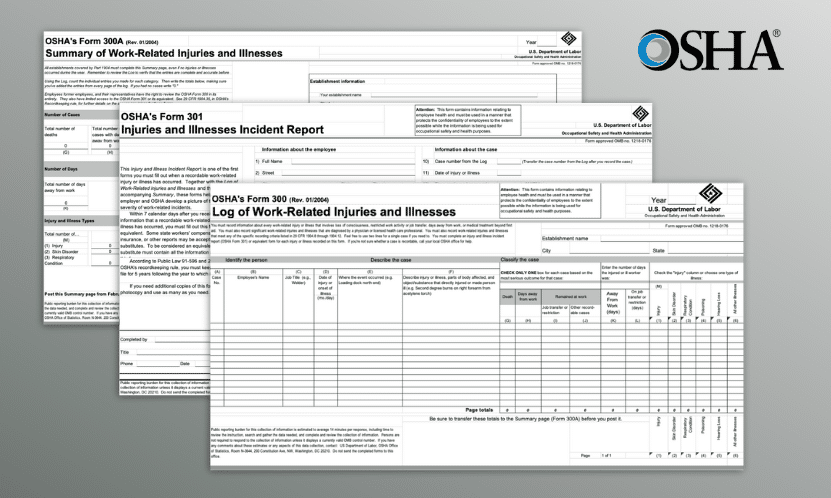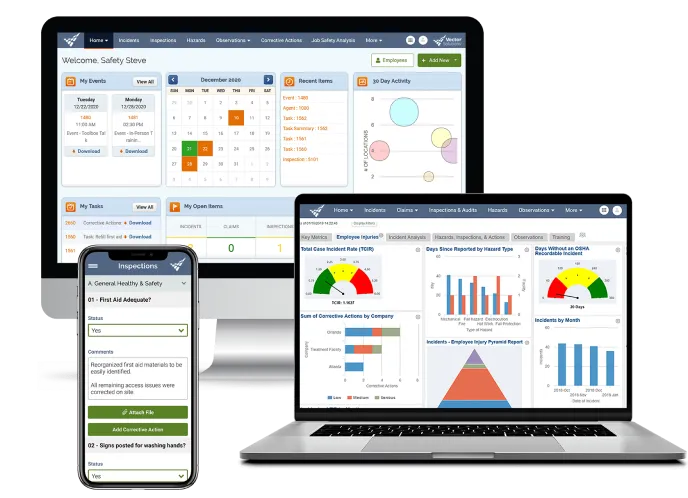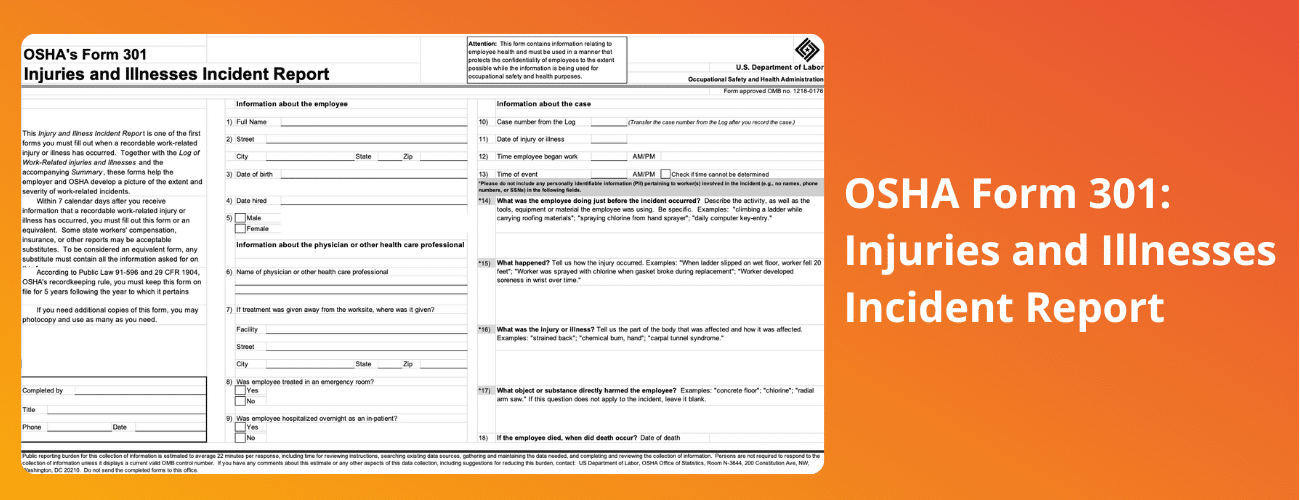September 16, 2024 7 min read

OSHA Reporting Forms: Everything to Know About OSHA 300, 300a, and 301 Forms
Industry:
Solution:

The Occupational Safety and Health Administration (OSHA) has specific requirements for recording workplace injuries and illnesses and reporting on them. There are three OSHA reporting forms: form 300, form 300A, and form 301. In this blog, we’ll provide an overview of each OSHA recordkeeping form, including when to use each and how to remain compliant with OSHA’s requirements.
When Do You Need to Report Injuries and Illnesses to OSHA?
The first important thing to understand is the difference between reportable and recordable incidents.
A recordable incident requires documentation on all three OSHA reporting forms for internal records. These incidents meet certain criteria, including a fatality, days away from work, restricted work, loss of consciousness, etc.
A reportable incident must be promptly reported to OSHA. These are severe incidents, including fatalities or hospitalizations of multiple employees. All employers are required to notify OSHA when an employee is killed on the job or suffers a work-related hospitalization, amputation, or loss of an eye. A fatality must be reported within 8 hours. An in-patient hospitalization, amputation, or eye loss must be reported within 24 hours. (https://www.osha.gov/report)
It’s possible for an incident to be both reportable and recordable, depending on how severe the incident is. In both cases, you must fill out the required forms and keep a record.
But it can be difficult to know when something needs to be reported right away. With Vector EHS Management, we make it easy. When you’re filling out your incident reporting forms in our system, they automatically adjust to display only the fields you must fill in based on previous inputs and it will notify you that the incident is reportable. We then make it incredibly easy to report to OSHA straight from our platform.
Vector EHS Management Brochure
Explore how you can bring all your organization’s EHS activities, tasks, and reports into one single, easy-to-use solution
Learn More
OSHA’s Reporting Forms: 301, 300, and 300A
To remain compliant with OSHA, employers must fill out these three forms for recordkeeping and reporting purposes. Together, the OSHA reporting forms help paint a picture of the extent and severity of work-related incidents at your workplace during a given year.
Let’s review each form in detail.

What is OSHA Reporting form 301?
OSHA Form 301 is the “Injuries and Illnesses Incident Report.” This is one of the first forms employers must fill out after a recordable work-related injury or illness has taken place.
This form must be filled out within seven calendar days after you have been informed that a recordable incident has occurred. OSHA then requires you to maintain record of this form for five years after the incident year.
The 301 form goes into detail about:
- The incident
- The impacted employee(s)
- And the physician or health care professional who provided care to the employee following the event

What is OSHA Reporting Form 300?
OSHA form 300 is the “Log of Work-Related Injuries and Illnesses” that have occurred during a specific year. OSHA requires every employer to record information about every work-related injury or illness that involves:
- Loss of consciousness
- Restricted work activity or job transfer
- Days away from work
- Medical treatment beyond first aid
- Significant work-related injuries as diagnosed by a physician or licensed health care professional
This recordkeeping form asks you to identify the person(s), describe the incident, and classify the severity.
Employers must also complete an injury and illness report (Form 300A) annually to summarize the incidents logged on Form 300. We’ll review Form 300A next.

What is OSHA Reporting Form 300A?
OSHA Form 300A is the “Summary of Work-Related Injuries and Illnesses” for a given year. All establishments covered by Part 1904 must complete this summary form even if no injuries or illnesses occurred during the specific year.
This form summaries all the individual incident reports you submit during the year, including the total number of cases, number of days away from work or on transfer or restriction, and the types of incidents that occurred.
OSHA Reporting and Recordkeeping Requirements
Just completing the OSHA reporting forms correctly isn’t enough. It’s important to stay up to date with the latest reporting and recordkeeping requirements from OSHA.
On July 17, 2023, the U.S. Department of Labor announced an update to these requirements. Now, employers in designated high-hazard industries must electronically submit these forms.
Download our comprehensive guide to complying with OSHA’s reporting and recordkeeping requirements to learn everything you need to know.
OSHA Reporting & Recordkeeping Guide
Learn how to comply with OSHA's requirements for reporting and recording work-related injuries and illnesses
Download Guide
OSHA Reporting Frequently Asked Questions
Properly maintaining incident records and knowing when to submit reports immediately is critical to avoiding OSHA fines and maintaining a safe workplace. Let’s address some of the top FAQs we hear.
Which are the OSHA recordkeeping forms?
Forms 300 and 301 are maintained throughout the year for your recordkeeping. Form 300A is the summary that you complete at the end of every year.
Who is responsible for OSHA reporting?
The person responsible for daily supervision over employees is responsible for OSHA reporting. Often this is the host employer.
The individual responsible for hosting will vary by organization. This responsibility generally falls to someone in the safety or compliance department, like a dedicated safety officer, though it may also be the responsibility of someone on your HR team or a site manager.
Take the time to figure out who at your organization is responsible for OSHA reporting to ensure you stay compliant.
How do state regulations differ from OSHA requirements?
We recommend researching the state(s) you operate in to learn about their specific requirements. In some cases, they may have more strict requirements, or they might have additional requirements on top of what OSHA requires.
Where can I find more information about OSHA requirements?
OSHA’s website has extensive information about their requirements for reporting and recordkeeping. We recommend starting with this OSHA reporting FAQ page on their website.

Why Companies Trust Vector EHS for Reporting and Recordkeeping
If you’re feeling overwhelmed with keeping up with shifting requirements, tracking all these forms manually or in spreadsheets, seeing an uptick in incidents on your work site, you aren’t alone.
Many of the companies we work with realized that staying compliant and making employees safer is so much harder without using a digital safety management and compliance solution.
But this EHS management software goes beyond incident tracking. It provides real-time incidents and an entire ecosystem of tools for end-to-end safety management.
“We are devoted to promoting and facilitating safety to our employees and community at large. With Vector EHS, we make sure no part of our safety program is overlooked, whether it’s notifying us of potential hazards, or scheduling regular inspections.”
— Safety Specialist, Lincoln Electric System
If you’d like to learn more about our safety solutions, request a demo today.









